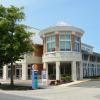If you ran a red light at the Five Points intersection in Lewes lately, you’re likely among more than 75 drivers who received a $137 ticket without ever being pulled over by police.
In mid-November, cameras homed in on drivers at the intersection of Route 1 and Route 9, which state officials decided was dangerous enough to warrant camera surveillance.
“We do it purely from a safety standpoint,” said DelDOT Deputy Secretary Nicole Majeski. “That's why we go through a very in-depth analysis to determine what intersections we add into this program.”
Nearly half of the 77 tickets issued at the Five Points intersection through the first week of December were given to drivers running the red light while heading east on Route 9 toward Lewes. Seventeen motorists traveling north or south on Route 1 also were ticketed for not stopping at the signal.
Five Points, now monitored by four cameras, is the sixth site in Sussex County in the state’s Electronic Red Light Safety Program, which began in 2004. Statewide, more than 50 cameras at 30 intersections captured nearly 40,000 red-light violations in 2015. A red-light camera violation is considered a civil offense, not criminal, and does not affect a motorist's insurance rates or driving record.
A DelDOT report shows statewide, red-light running crashes declined by about 25 percent and total crashes were reduced about 4 percent at intersections where cameras were installed.
But in the Cape Region, the intersection at Route 1 and Old Landing Road does not follow that trend. The intersection saw an increase in angle crashes – right-angle crashes or crashes caused by left-turns through red lights – as well as red-light running crashes and rear-endings.
In Sussex County, the report shows the total annual average of crashes increased at three of the five intersections with cameras – including the two camera-controlled intersections on Route 1. Crashes related to running red lights declined, except at the Old Landing intersection, but at all five Sussex County sites, rear-end crashes increased.
“I think from a safety standpoint, what we've seen since the implementation is the reduction in the red-light running crashes and angle crashes where we see significant injuries tied to them,” Majeski said. “There's a benefit.”
Before a red-light camera goes live, engineers with the Delaware Department of Transportation say they gather safety data on a proposed intersection.
Majeski said the DelDOT officials review whether increased lighting, more signage or re-striped roads will fix safety problems before red-light cameras are installed. At Five Points, those steps had already been taken, Majeski said, and crashes continued.
A DelDOT study found motorists running red lights at the Five Points intersection caused 16 of 22 at-fault crashes recorded at the intersection between 2010 and 2014, data that prompted the decision to install the cameras.
The Five Points intersection is one of 16 sites statewide to go online in 2016-2017. In Sussex County, red-light cameras also are posted at Route 1 and Munchy Branch Road and Route 1 and Old Landing Road, both in Rehoboth Beach; U.S. Route 13 at Redden Road in Bridgeville; U.S. Route 113 at Route 20 near Millsboro; and U.S. Route 13 at Tharp Road in Seaford.
The state contracts Xerox for all of its red-light cameras, and in 2015, the program cost about $2.8 million to operate. Elsmere, Dover, Newark and Seaford are in charge of the red-light cameras in their jurisdiction, which are also provided and serviced by Xerox.
Red-light cameras generated about $3.8 million in total revenue in 2015, resulting in a nearly $1 million net profit to the state and municipalities. About $580,000 went to state's coffers, while Dover took home $345,000 and Newark received $150,000; Elsmere's expenses were about $20,000 greater than the program's income, while Seaford was about $60,000 in the red for the year.
Since 2010, the red-light program has generated a total of about $9 million to state and municipal governments after expenses were paid, DelDOT's red light analysis report for 2015 shows.
For more, go to deldot.gov.























































